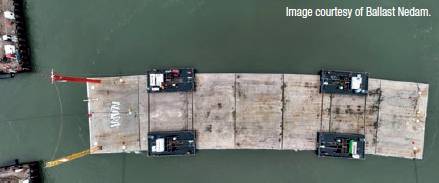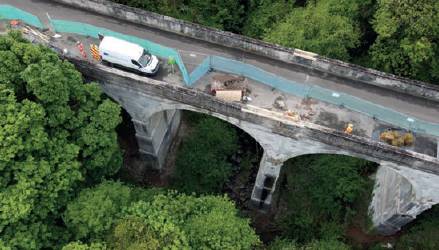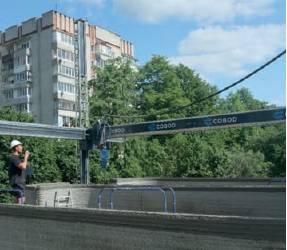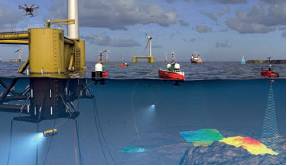
Second tunnel element of the Maasdelta tunnel in Rotterdam given immersion date
Rijkswaterstaat, construction consortium BAAK (Ballast Nedam and DEME) and partners will immerse the second tunnel part of the Maasdelta tunnel in October. The tunnel is part of the A24 Blankenburgverbinding, crossing the Nieuwe Waterweg in the Scheur in Rotterdam. It follows the successful immersion of the first tunnel element in March.
The tunnel will provide the major port city with a new crossing at 185m long, 40m wide and seven metres high. Immersing and connecting the element is a slow process for one of the world’s busiest waterways. Concrete tunnel elements are built in a construction dock and are temporarily sealed on both sides with headboards and floated to their final location. At their location, a trench is dug in the waterbed where they are immersed. Once sunk and in place, rubber GINA profiles form the watertight connection between the tunnel elements and the temporary headboards are removed.
Youth infrastructure safety contest announced to improve streets
The Your Voice, Your Action = Youth Infrastructure Safety contest, through National Organisations for Youth Safety and Bentley Systems encourages young people to identify a problem in their neighbourhood and propose a solution that affects pedestrian safety and propose a solution to fix it, has opened to young people in the USA aged 15-29. The contest aims to give young people an opportunity to voice what infrastructure improvements are needed in their neighbourhoods to support and equitable use of street spaces. Entrants propose and justify design alternatives on how their proposal will lead to a more secure, environmentally-friendly transportation system for all road users.
Participants attend classes from Bentley experts to develop their CAD skills using Bentley’s MicroStation, with a $1,500 prize up for grabs and a certificate of training from Bentley Systems. To enter submit a project before 31 December via www.noys.org/yvya.
‘Green transition’ pilot initiative phase concludes
The European Space Agency has concluded its initial phase of a pilot initiative in Austria that demonstrates the untapped potential of space technologies by providing actionable Earth observation information to accelerate the green transition for both society and the economy. The Green Transition Information Factory – a cloud-based platform using Earth observation and other geospatial data is part of the Space for Green Future Accelerator, which was introduced in 2021 to explore the potential for transitioning to carbon neutrality by 2050. It will be one of the key ambitions that the ESA will table at the 2023 European Space Summit.
A new £1.5m scheme will investigate 3D printing techniques in managing and maintaining UK water supplies
The repair and maintenance of water infrastructure across the UK is set to be transformed by the introduction of 3D printing expertise from Manchester Metropolitan University. Researchers from the university will be helping to 3D scan and print replacement parts to help manage and upgrade the equipment that looks after water supplies, creating vital parts on demand.
As part of the £1.5m project, United Utilities – which provides water and wastewater services in the north west of England – will work with Manchester Met, ChangeMaker 3D and Scottish Water, to develop the ‘Water Industry Printfrastructure’. The aim is to tackle the environmental and logistical challenges in sustainably maintaining and upgrading the water supply system. The project will run until October 2024.

Second longest suspended bridge on Continental Europe inaugurated in Romania
The two banks of the Danube River in southeast Romania have been joined by the new Braila Bridge – the longest in the country at 1,975m in length – the second longest suspended bridge on continental Europe.
The structure was built by an international consortium led by Webuild.
Diversitas is launched as a new umbrella body for black professionals in the built environment
Launched at its council meeting in June, the Construction Industry Council (CIC) has facilitated the development of Diversitas. The umbrella body was created under the direction of CIC’s Chair, Justin Sullivan with a goal to increase representation of black professionals within CIC networks and the built environment.
Chaired by Jessica Taylor (partner, Ashfords LLP) supported by vice chair Gail Royston, the first member organisations of Diversitas are: DiverseCity Surveyors, Association For Black and Minority Ethnic Engineers (AFBE-UK ), Black Professionals in Construction (BPIC Network) and BAME Planners Network. In addition, Diversitas will look to further increase their membership and profile to encourage a wider representation of black professionals within the built environment sector.

HS2 reveals first giant lake piers for record-breaking Colne Valley Viaduct
The first piers that will carry the viaduct over a series of lakes just outside London has been completed. For the last year, a 700-tonne ‘launch girder’ – the only one of its kind in the UK – has been assembling giant pre-cast concrete segments to form the first kilometre of the viaduct deck along the edge of the valley. Each pier weighs 1,800 tonnes and will support a row of arches inspired by the flight of a stone skimming over the surface of the water. There will be 11 piers covering the water in total with another 45 on land.
The Colne Valley Viaduct – which is being built near Hillingdon – will carry high speed trains more than two miles (3.4km) across the Grand Union Canal, River Colne, local roads and a series of lakes between the London tunnels and the Chiltern tunnels.

More than 240 repairs completed on heritage concrete viaduct in East Renfrewshire
A maintenance programme involving more than 240 separate repairs has been completed on the impressive six-arch Aurs Burn Viaduct in East Renfrewshire. Built in 1901 as part of the former Paisley and Barrhead District Railway used for freight, which closed in 1941, the concrete viaduct runs for 350 feet over Aurs Burn stream flowing from Glanderston Dam and down towards Barrhead. It needed extensive renovations which contractors for National Highways’ Historical Railway Estate tackled over two phases.
Phase one of the work included resurfacing of the deck and repairs to the concrete arches in spans five and six. Phase two saw an inspection of the four other spans and repair work carried out, including stainless steel anchor studs drilled into underlying concrete to anchor the repair mortar to the existing structure.
Sale of MOD site in Cambridgeshire to bring new lease of life to area
The MOD has completed the sale of Waterbeach Barracks in Cambridgeshire, paving the way for a major redevelopment of the site to provide new homes, schools, and community facilities, as well as a haven for wildlife. The site has been sold to Urban&Civic, part of the Wellcome Trust with the development delivered in stages over the next 20 years, will provide 6,500 new homes and five new schools. More will follow, including a town centre, parks, and 250 acres of green space.

COBOD’s 3D Construction printing technology is helping to rebuild Ukraine
Led by the humanitarian foundation Team4UA and carried out by the Danish 3DCP Group using COBOD’s BOD2 printer, a groundbreaking initiative aims to address the pressing need for educational infrastructure in Ukraine by rebuilding a school in Lviv. The full-scale invasion by Russia has resulted in the destruction or damage of over 2,000 schools, with 277 schools completely demolished, as reported by the Ministry of Education and Science of Ukraine. This initiative aims to expedite the creation of educational facilities and lay the foundation for the reconstruction of housing and vital infrastructure throughout Ukraine, with more projects to come.
Engineering skills needs – now and into the future
A recent EngineeringUK-commissioned report which explores engineering and technology skills needs, and how these have changed across the engineering sector in recent years, has provided detailed insights into the engineering and technology sector. It concludes that the number of engineering jobs will grow in all UK regions between now and 2030, and that there is an increase in ‘green’ engineering jobs. For more info, visit https:// tinyurl.com/2v53k64v.

eDNA to measure biodiversity at offshore wind farms
The BeWild project, aimed at measuring biodiversity at offshore wind farms, was recently launched at Fugro’s TechCenter in Nootdorp. Alongside project partners, the focus will be on developing innovative solutions for remotely collecting environmental DNA (eDNA) samples in the North Sea. Collected data will assess the impact of offshore wind farms on biodiversity and explore ways to adapt infrastructure to enhance marine habitats.
Remote marine eDNA collection, analysis, and interpretation capabilities will be developed as part of its solutions. By also integrating the eDNA sampling into its uncrewed surface vessels and remotely operated vehicles, Fugro aims to not only inspect subsea assets but also the broader subsea environment to advance our understanding of offshore wind farm biodiversity and contribute to sustainable offshore energy development.
In brief:
Hornsea Four offshore wind farm, which Ørsted is proposing to develop in the North Sea, approximately 69km off the Yorkshire Coast, has been approved. It will be the second largest in UK waters after the yet-to-be-commissioned Hornsea Three.
AECOM and Bechtel are to serve as infrastructure delivery advisors for Ukraine reconstruction.
The Norwegian Hydrographic Service has awarded Fugro a new hydrographic survey contract for the 2023 MAREANO seabed mapping programme to continue mapping Norway’s seabed to help preserve marine resources.
The Department for Science, Innovation and Technology has appointed Nick Bolton as the new chief executive of Ordnance Survey. Nick will take up the leadership in October 2023.
National Highways will introduce a new flight management system to make it easier to plot the use of drones across the country. The new system will improve safety through better co-ordination and visibility of flights by sharing information with organisations such as Network Rail, and National Grid.
The Bergen Åsane 12.7km line tramway extension on the Bybanen light rail network in Norway from Kaigaten in the city centre north to Vågsbotn in Åsane has been given final approval. Dependent on financial commitments, construction could start in 2024. Approved conceptually in 2018, consultations found objections to the tramway along the historic Bryggen. Project promoter Bybanen Utbygging has awarded CORAV consortium of COWI Norge, Ramboll, and Asplan Viak the design work.
The Alan Turing Institute has secured £3m to establish a new digital twin research network ‘NetworkPlus’ which will help to address gaps in the current research landscape and transform the UK’s capability in digital twinning.